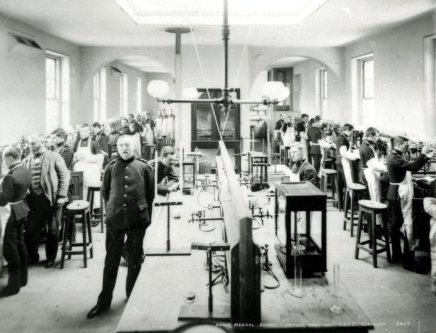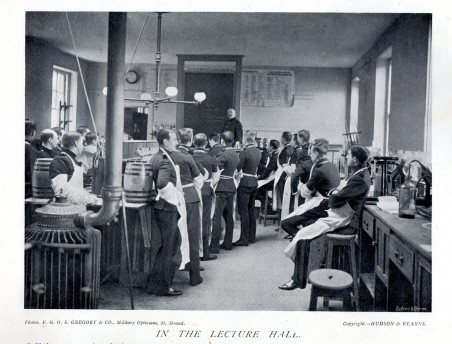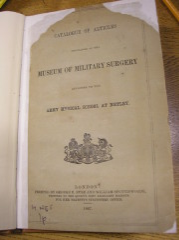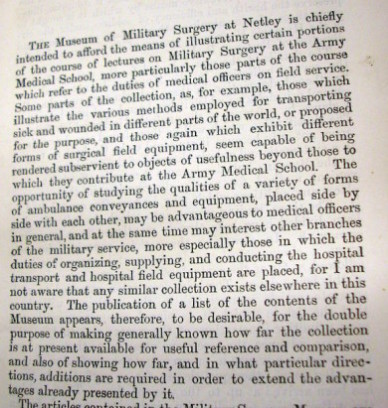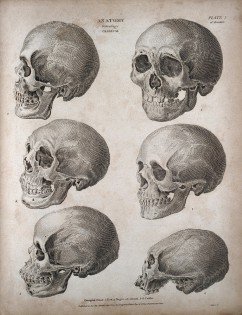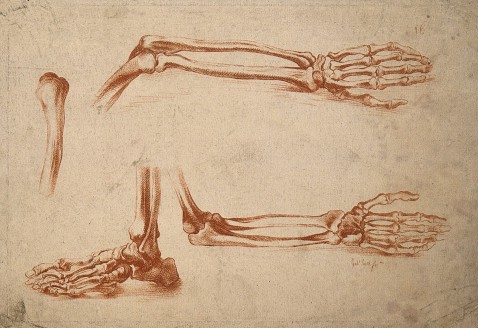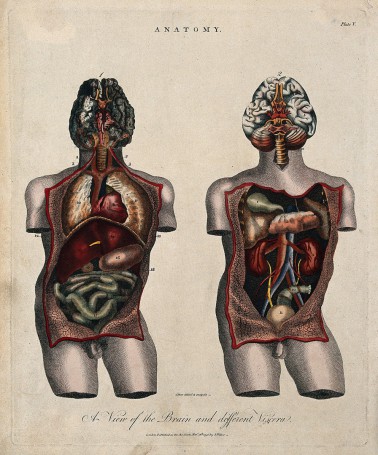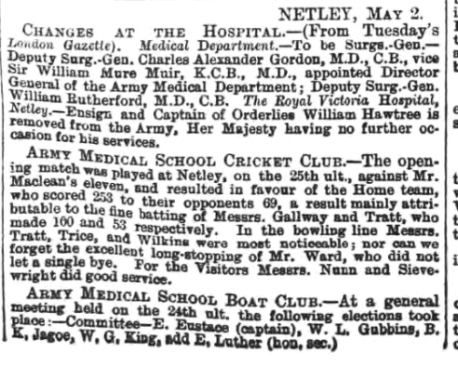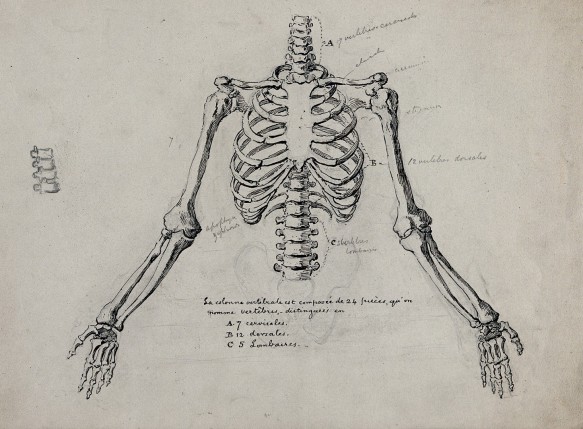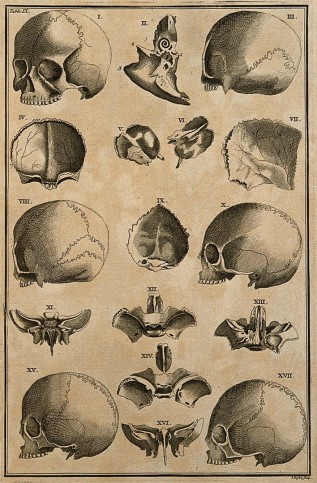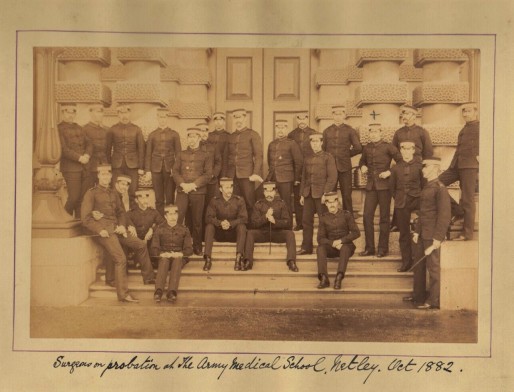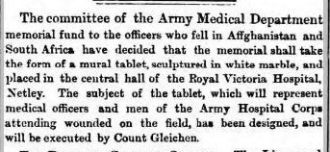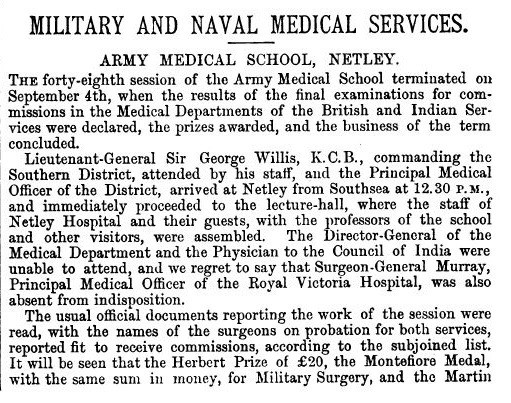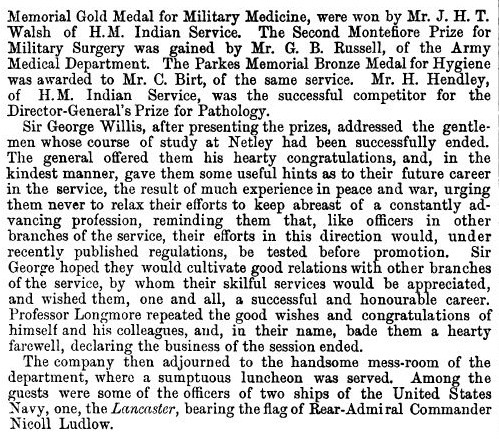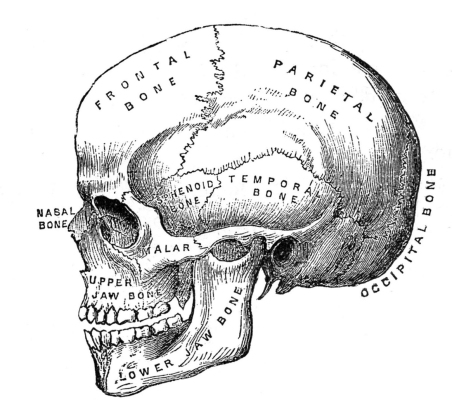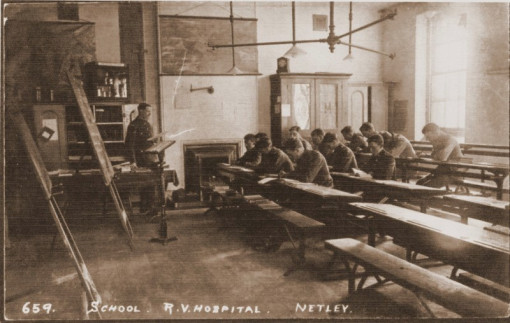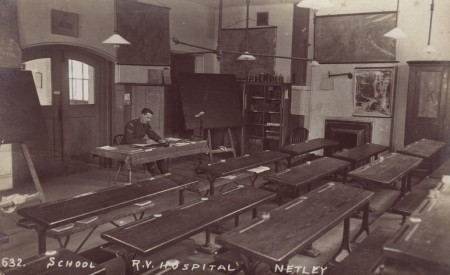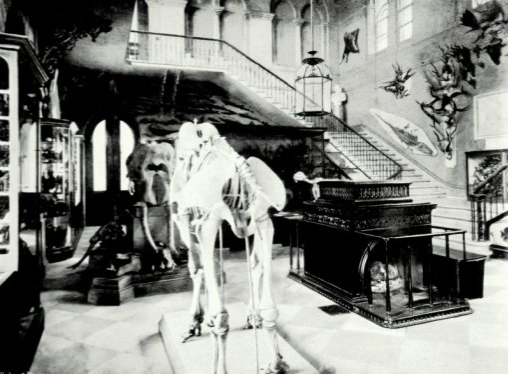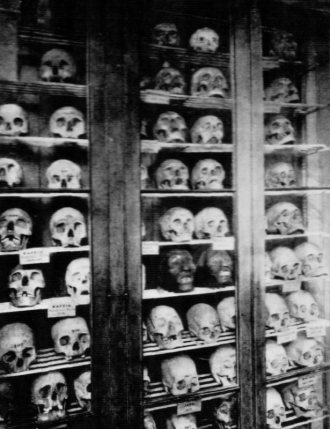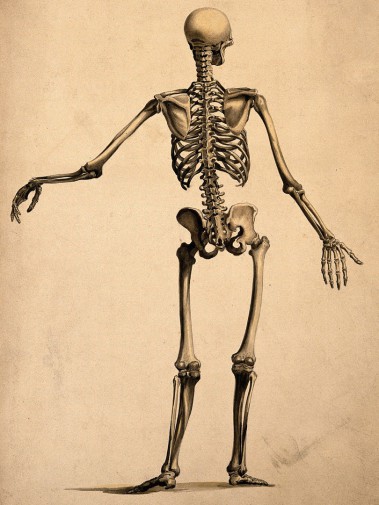
The Army Medical School
The Army Medical School was sited at Netley for a while. Young surgeons became acquainted with nearly all the wounds and special diseases from which the British soldier suffered and they had the advantage not only of learning the discipline of the Service, but of having contact with the distinguished medical officers who were always present at Netley like Dr. Edmund A. Parkes, Sir Thomas Longmore and Professor William Campbell Maclean.
A classroom at Netley
This is a catalogue of articles (from Southampton Central Library) contained in the Museum of Military Surgery attached to the Army Medical School at Netley written in 1866 by Sir Thomas Longmore. It lists hundreds of items including arms and weapons: clubs, spears, bows and arrows, blowpipes, firelocks, cannons and shot, daggers, knives, swords, axes, Assegai, pistols, muskets, powder flasks of buffalo horn, cartridges, hand grenades, shells and fuses.
Surgical field equipment and means of conveying it: Bandages, wooden and straw splints, surgical instruments, forceps, bullet scoops, extractors, candlesticks, artificial limbs and crutches, models of two and four wheeled carts, hammock litters, field stretchers, assorted stretchers from around the world - dhooley, palki, jampan.
Donkey carts, hand litters, cots and hand barrows.
A military and naval cat o' nine tails.
A list of many drawings of medical instruments and conveyances.
These lists in this booklet gives us an insight into what the museum might have looked like while the school was there. Many were donated and their origins are noted.
From:
THE CHEMIST AND DRUGGIST
September 14, 1895
NETLEY
ON the east of Southampton Water is situated one of the most remarkable medical institutions in the world — Netley Hospital, the headquarters and training-school of the medical officers of the British and Indian armies. Some who attended the recent Pharmaceutical Conference may have seen it when they took the trip to the Isle of Wight, as the hospital is the most conspicuous building on the left going eastwards. It is a magnificent structure in red brick, with white-stone facings. Its frontage is more than a quarter of a mile long, and as the corridors extend the whole length of the building, they are reputed to be the longest in the world. Lawns lie between the hospital and the water, and the extensive grounds, with their charming walks, leave plenty of space for officers' quarters, and a score of other buildings besides the hospital.
Many a chemist and druggist may have come within a stone's throw of the hospital without visiting it, and for that reason we wish to apprise the trade that a welcome is given to all who are interested in medical treatment if they call any day between 10 and 4. There is a pretty little museum of natural- history specimens which old students of the hospital have brought home or sent home, and the corridors and wards afford food enough for reflecting upon the moral and physical stamina of Mr. Thomas Atkins. The hospital receives all soldiers invalided from tropical climates, who come to the hospital immediately on their arrival home. There is accommodation for 1,300 patients, but 1,500 could be taken at a push, and during the winter there is seldom fewer than 1,250. Then is the season that the sick men are sent home by the hundreds.
All the medical practitioners who succeed in passing the Entrance examination for the Army Medical Staff and the Indian Medical Service have to put in a period of instruction at the hospital and the medical school attached to it. They thus become acquainted with the peculiar kinds of diseases which are met with in the army, while they attend lectures on special medical subjects, and are instructed in all the duties and regulations pertaining to them as officers of the army, after which they must pass the outgoing examination, which gives them the choice of vacant appointments.
Through the courtesy of Brigade-Surgeon Lieut. -Colonel Evatt, a representative of The Chemist and Druggist was recently shown over the hospital and school by an orderly of the Medical Staff Corps ; and as it is from members of that corps that army compounders are manufactured, our representative walked through the hospital with an eye mainly to the duties of these men, and the prospects of the service for chemists' assistants. In spite of an open mind on the subject, our representative had come to the conclusion, before he was half through the wards, that chemists' assistants should leave the Corps severely alone. Curiously, that opinion was confirmed by the orderly, a smart and intelligent young fellow, who had served a five-years' apprenticeship to the drug trade.
This is exactly what our representative saw. At the Netley railway-station a company of the corps was waiting the train by which about 50 invalided men arrived. The Corps helped them with their luggage and took charge of them until they reached the hospital. There more of the Corps men gave out the hospital uniforms from the clothing department, and others took the invalids to their wards. In these wards one could see men of the M.S.C. engaged in cleaning, or directing the sturdier of the inmates in such operations. There is a small staff of female nurses, apparently to give tone to the place, but all of the M S C. have to serve a period at nursing. Now the large majority of the cases are of fever and venereal complaints. Several of the wards for the latter are not open to spectators nor to female nurses, because the cases are so loathsome. It is the M.S C. men who have to nurse these cases. Details would be horrible; we need only mention that it sometimes takes a man a whole day to clean and dress the sores of one syphilitic patient. After this, all the fetching and carrying which has to be done becomes easy and pleasant work.
There is very little pharmaceutical work to be done. Three compounders do all that is required in Netley, and as far as could be judged during the visit the work is neither onerous nor high class. The dispensary consists of two rooms, clean, orderly, and well-lighted, but not particularly well-appointed. It compares very badly with corresponding dispensaries in the United States Army Medical Service, which have neat nests of drawers, recess-labelled bottles, excellent apparatus, balances, &c, and a set plan of arrangement, so that any compounder in the service may begin work in it after a brief look around. The Netley dispensary looks as if it had seen much service. In the dispensary proper the bottles are of all sorts and sizes, the labels what the ingenuity of the compounders has made them, but little attempt at uniformity. There is a poisons cupboard, and, as we have said, everything is scrupulously clean. The second apartment is the stockroom, containing the medicines as received from Woolwich, and mostly bearing the labels of wholesale houses, those noticed being the Apothecaries' Society of London, Evans, Lescher & Webb, Herrings & Co., Savory & Moore, and Wright, Layman & Umney.
Our representative had spoken to Brigade-Surgeon Evatt about the support which the English Local Government Board had given the Corps by making ex-compounders eligible for poor-law dispenserships. The brigade surgeon and a sergeant in his office thought their men quite fit for the appointments, but the specimen in the dispensary was a splendid proof to the contrary. His replies to some questions were of such a nature that it required the orderly's assurance that the man bad passed as a compounder to convince our representative that he knew anything about medicine. Our man remarked that the dispensary solution of quinine was red, and the compounder explained that was because quinine is red. He was gently told that it is white. " Oh, no " said he, " it's always red. I never saw white quinine "; and he produced his bottle, which, true enough, contained pink quinine, the label stating that it is coloured" to prevent peculation." There were many things in the poisons cupboard besides poisons, but the compounder did not know that. What a pertinent comment on the L G.B.'s recent action! Whether this man is a fair sample of the bulk or not we do not venture to say; indeed, the orderly assured us that the chief-compounder at Netley is a reliable dispenser, but, at the same time, he said it is not for that work that any young druggist should join the Corps. As a pharmaceutical calling it is, to put it very mildly, disappointing. Those who wish to join it must enlist for the usual twelve years' service (part of which is with the Reserve), and conform to all the regulations bearing upon the private soldier, except in regard to much of the drill.
They will have the satisfaction of serving under the members of the Army Medical Staff, who, unfortunately, are not all as nice to their inferiors as Brigade-Surgeon Evatt, whom to salute must be a pleasure; and they will have to do many things which their training in pharmacy must render repellent. The worst of it is that Netley is the best of it.
https://archive.org/stream/b19974760M0863/b19974760M0863_djvu.txt
Here are two photos from the Museum of Military Surgery which was in the entrance hall of the hospital near to the medical school where the young Army surgeon could complete his studies in comparative anatomy and botany. The bottom picture is called "Skull Alley" which gives the student an insight into the different facial characteristics of people from other countries of the world.
(from the Navy and Army Illustrated 1897)
